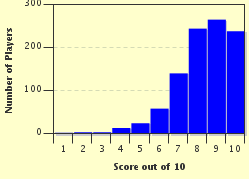Quiz Answer Key and Fun Facts
1. The following types of work MAY have been written by a slave who MIGHT have lived in ancient Greece between 620 and 560 BC...
Or perhaps not.
Some controversy exists as to whether he was actually even a real person or not, but fables bearing his name are perennially popular, and usually contain a "moral" at the ending of the tale.
What is the name that is most commonly associated with fables?
2. This little boy was the product of English folklore, and when I say little, I really mean he was SMALL! Who was this tiny son of "Thomas of the Mountain", according to the story as it was written in 1621?
3. The cute little story of Hansel and Gretel, a pair of siblings that were lured to the gingerbread house of a witch, was a part of a collection of stories that the Brothers Grimm compiled. It did NOT start off as such a cute tale. In fact, its main focus seemed to revolve around a "feast-or-famine" mentality. Literally.
Not only did the witch in the story wish to eat them, the children's own parents had abandoned them in the woods for what reason?
4. A North American folklore legend, Paul Bunyan, had a seriously overblown persona. He was a giant lumberjack in the Northwest U.S. and in portions of southern Canada. His skills were unsurpassed and he seemed to be too good to be true. Perhaps that was the intent of the story lines and part of the mystique surrounding this character as he performed all sorts of exaggerated feats in the wilderness of the great North Woods. He had a "sidekick" of sorts, as most legendary heroes are prone to have.
What was the name of his giant animal companion?
5. What old crone of Slavic and Russian folklore lived in a house that stood on "stilts", which were nothing more than chicken legs?
(In the stories, she herself is often referred to as "chicken-legs".)
6. A tale of a young boy who trades the dried-up family cow for a handful of beans, which grow to a tremendous height, leading the hero above the clouds, and ultimately killing a giant. - Well, of course we all know that this is the story of "Jack and the Beanstalk". Many oral and written versions of this story abound throughout the world, but what I'd like to know is this:
In what year did the version appear that most of us are familiar with, as written by Joseph Jacobs in "English Fairy Tales"?
7. This story was based in New York, in an area originally settled by the Dutch. Ichabod Crane was the local school teacher, but one dark night he had an encounter with a headless horseman. Of what nationality was this supposedly "headless" rider?
8. An Italian who had served as a volunteer for the Tuscan army in The Wars for Independence in the 1800's, Carlo Lorenzini wrote what later became an extremely popular children's story in 1883 and over a half century later became an animated movie produced by Walt Disney Studios in 1940. Carlo used a pen name when writing this particular tale; that of Carlo Collodi.
Now, what WAS the name of that fairy story that featured such characters as the Fairy with Turquoise Hair, an anti-hero named Lampwick, and an impoverished and child-hating woodcutter named Geppetto?
9. Charles Lutwidge Dodgson wrote a sequel to an earlier book that he had written for a young girl named Alice Liddell. Most people could tell me the title of the first book was Alice's Adventures In Wonderland, but can you tell me the COMPLETE title of the SECOND book that he wrote?
10. I think we'll have a stinker of a "thinker" for this question. What European fairy tale is this that was published in 1740 and was originally entitled, "La Belle et la BÍte"? Okay, so you don't speak French. Let me give you some clues.
1. The girl in the story was a merchant's daughter (or the child of a king and a good fairy, depending on which version you read.)
2. The man was a hideous creature (or a dashing young prince.)
3. In 1991 Walt Disney studios produced an animated musical about this story.
Okay, that's it. No more clues. Which of these is the subject of this question?
Source: Author
logcrawler
This quiz was reviewed by FunTrivia editor
looney_tunes before going online.
Any errors found in FunTrivia content are routinely corrected through our feedback system.

